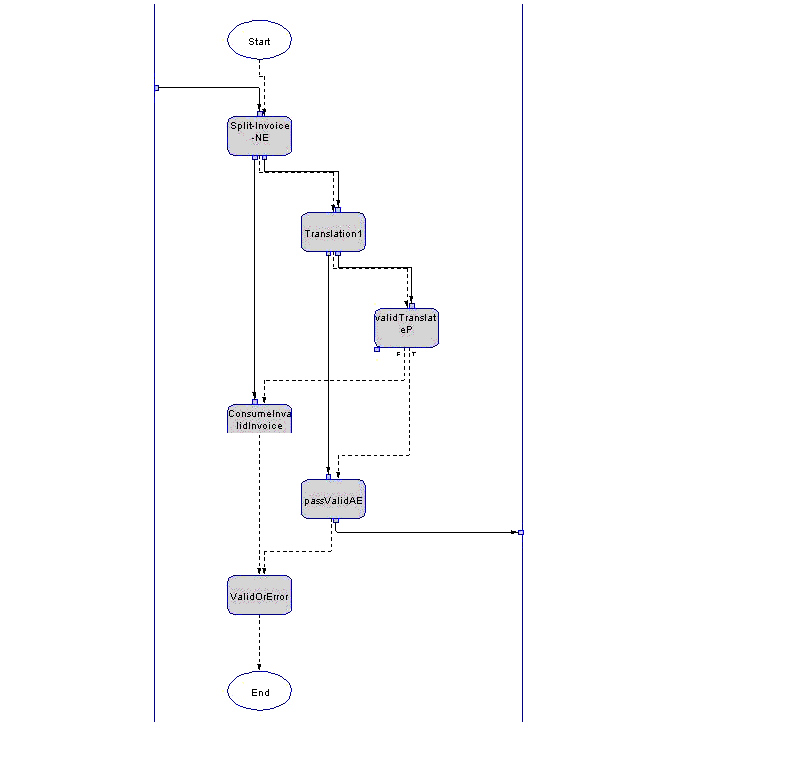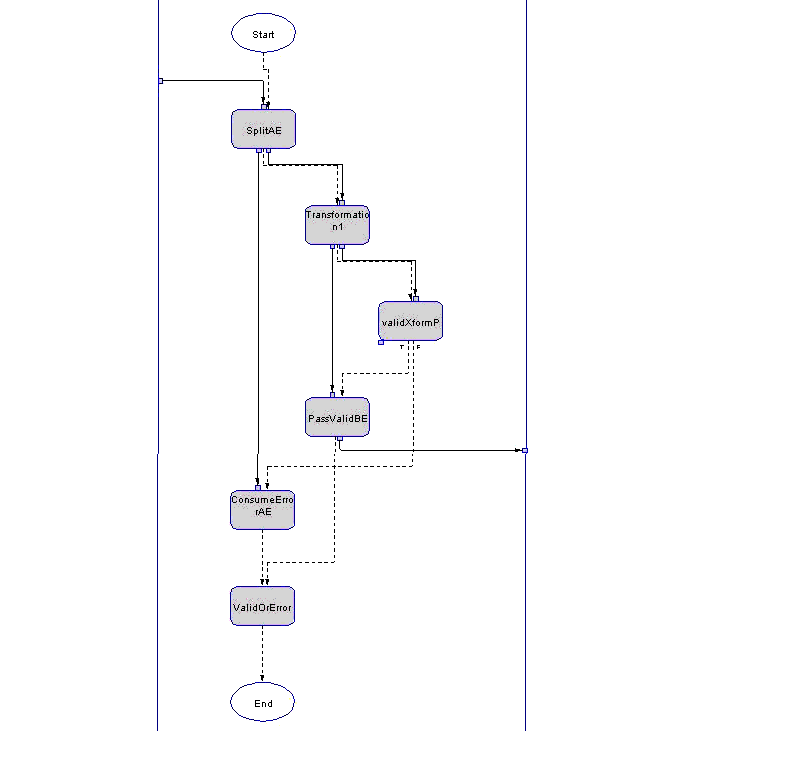10g (9.0.4)
Part Number B12121-01
Home |
Solution Area |
Contents |
Index |
| Oracle® Application Server ProcessConnect User's Guide 10g (9.0.4) Part Number B12121-01 |
|
This chapter describes how to detect and handle system and domain errors in Oracle Application Server ProcessConnect runtime components.
This chapter contains these topics:
The following sections for additional details on viewing Oracle Application Server ProcessConnect errors:
See Also:
This section describes administrator types and errors, provides domain error modeling examples, and describes the implications of role and event instances being in an error state.
This section contains these topics:
This section describes tasks typically performed by the following administrators:
The system administrator manages Oracle Application Server ProcessConnect components and monitors and diagnoses the Oracle Application Server ProcessConnect runtime behavior.
The system administrator must ensure the following:
The business administrator monitors and diagnoses the semantic correctness of an integration.
The business administrator must ensure the following:
Oracle Application Server ProcessConnect distinguishes between two types of errors:
These errors occur because of incorrect metadata or profile data. For example:
These errors occur because of system failures. For example:
The fundamental difference between domain errors and system errors is that you can design domain errors as part of normal business process modeling. This is achieved by providing special error ports on steps where domain errors occur. These ports are then populated with either success or failure values. You can then design the error case.
Note that in fixing a domain error, you as the modeler must typically modify metadata information (or the business administrator must modify the profile data), which requires redeployment of the business process.
In contrast, a system error correction typically does not involve redeployment of the business process.
The Oracle Application Server ProcessConnect user interface tool enables you to automatically create a step return code port that captures domain error details in the following role steps:
The step return code port is automatically created as an outbound step port when you create a condition, translation, or transformation step. This port connects only to other step ports because it has a datatype, and never to role ports because role ports require event types. Figure 21-1 shows a step return code port in a transformation step of a transformation binding role and all other required steps. While the example shown in Figure 21-1 includes a transformation step, the step return code port in a translation step requires you to create similar functionality.

|
Note: Ensure that the step return code port error handling you create is simple so that it does not result in domain errors. For example, avoid using domain value maps without defaults in Transformation Step 2 in Figure 21-1. |
Table 21-1 describes the step return code port and step activity shown in Figure 21-1. The step return code port is automatically created when you create a transformation, translation, or condition step. You must manually create all other steps, step ports, and data flows shown in Figure 21-1 and described in Table 21-1.
Table 21-2 describes the tasks to create the steps, step ports, and data flows shown in Figure 21-1. References are provided to the procedures for performing these tasks. If you create a step return code port in a translation step, you must perform similar tasks.
| Task | See Also... |
|---|---|
Note: The step return code port is automatically created as an outbound port to another step on the condition step and on both transformation and translation steps. |
Note: The modeling wizards only create an initial transformation or translation step in a role. Manually create the second step. |
|
Note: The modeling wizards only create an initial transformation step's data flow or step port. Manually create all remaining step ports, control flows, and data flows. |
|
See Also:
"Creating an Alert E-Mail Message Native Format" for additional tasks to perform if you want to include error details in an e-mail message, including creating all remaining roles of a spoke for an integration, creating the E-Mail adapter interaction, specifying token substituted text as the native format, and creating an application agreement |
Figure 21-2 shows an additional example of how domain error modeling appears in the Process Diagram for a translation binding role.

Figure 21-3 shows an additional example of how domain error modeling appears in the Process Diagram for a transformation binding role.

|
See Also:
|
As described in Chapter 3, "Oracle Application Server ProcessConnect Concepts" and Chapter 12, "Managing Business Processes and Roles", a coordination represents the execution of the business transaction represented by the modeled business process. A coordination consists of the full set of role instances and event instances that are bound to a specific business process. A native event instance is created from the wire message received by the adapter framework. As the event is processed by various roles in Oracle Application Server ProcessConnect, the appropriate role instances are created. The event can be translated into an application event instance and transformed into a business event instance before executing the business process. The various event instances and role instances and their states are described in Chapter 3, "Oracle Application Server ProcessConnect Concepts".
An event instance is set to an error state in the following scenarios:
When the native event is set to an error state while being raised by the adapter, there is no corresponding role instance associated with it. Therefore, there is no impact on states of any role instances or coordinations. However, when an event is set to an error state because of a domain error in one of the steps you designed, the subsequent processing depends on the designed behavior, which can be one of the following:
In this case, the input event into the current step is set to an error state and the execution of the steps continues along the false path out of the condition step. There is no impact on the state of the current role instance or the current coordination
For example, say a createPO event (POID: 123) runs into a transformation error. A subsequent updatePO (POID: 123) event that is correlated to the createPO event cannot then be raised after the createPO (ID: 123) event runs into the transformation error because this results in the corresponding role instance and the coordination being put into an aborted state.
Assuming that updatePO (POID: 123) was raised before the transformation error, the native event is raised successfully. However, the native, application, and business events corresponding to the updatePO event are subsequently set to an error state depending on when the transformation error occurs and which role is processing updatePO at that time.
For system errors such as a database going down due to insufficient memory or tablespace problems, Oracle Application Server ProcessConnect retries periodically until it succeeds. You do not need to design for these errors.
This section describes the various methods for detecting and handling errors that can occur during the execution of the business process.
Oracle Application Server ProcessConnect captures various runtime error details. Table 21-3 describes where to look for this information.
| Area | Description | See Also |
|---|---|---|
|
Oracle Application Server ProcessConnect user interface tool error reports |
Error reports are useful for diagnosing errors directly related to event processing in roles and steps, such as: |
"Error Status Report" to create a report "Monitoring Current Errors in an Integration" for an error report example |
|
Oracle Application Server ProcessConnect user interface tool event status and details reports |
Event status reports can be generated using the event state as a filter. This enables you to create a report for events in an error state. In the details section of the report, you can navigate through the errored event predecessor events to identify the origin and context of the errored event (role step and port information, and so on). |
"Event Status Report" to create a report "Monitoring iProcurement Process Status" for event status report examples |
|
Oracle Application Server ProcessConnect user interface tool coordination status and details reports |
Coordination status reports can be quickly generated to identify erroneous business transactions. The details section of the report lists all the roles and event instances involved in a coordination.
|
"Coordination Status Report" to create a report "Monitoring Coordination Details" for a coordination status report example |
|
Oracle Application Server ProcessConnect system metrics through the Oracle Enterprise Manager Application Server Control |
You can use the Oracle Enterprise Manager monitoring functions to check for errors. For example, you can check the following: |
"Oracle Application Server ProcessConnect Monitoring and Administration Tasks" to access the Oracle Enterprise Manager Application Server Control from which you can view Oracle Application Server ProcessConnect status and adapter framework metrics |
|
Oracle Application Server ProcessConnect log and system exception files through the Oracle Enterprise Manager Application Server Control |
Errors occurring during operation of the integration manager and adapter framework are logged to component specific log files and as system exceptions in the runtime repository. In contrast to the preceding errors, these errors are not directly related to event processing: |
"Oracle Application Server ProcessConnect Monitoring and Administration Tasks" to access the Oracle Enterprise Manager Application Server Control from which you can view log files |
|
Oracle Application Server ProcessConnect log files through the Oracle Enterprise Manager Application Server Control |
Fatal JVM errors preventing the integration manager and adapter framework from continuing are logged to OC4J log files in the |
"Oracle Application Server ProcessConnect Monitoring and Administration Tasks" to access the Oracle Enterprise Manager Application Server Control, from which you can view OC4J log files |
Table 21-4 describes typical adapter framework errors.
Table 21-5 describes typical integration manager errors.
You can send an alert e-mail through the E-Mail adapter. This e-mail typically contains the following details:
Alert e-mails consist of a subject and message body. Example 21-1 shows an alert e-mail example:
FROM: ip@oracle.com SUBJECT: my_po_bp.transform_po transformation failure Transformation step transform_po failed in business process my_po_bp for purchase order #12345 with error: Error -: AIP-10422: Transformation step callout failed during execution: oracle.tip.ts.transformation.api.exception.DomainResourceException: Error -: AIP-14004: Error in invoking domain value function lookupBusinessViewDomain.
To produce the alert e-mail, you must create a transformation to produce the appropriate event type for delivery through the E-Mail adapter. In most cases, the transformation occurs in a context event such as a purchase order so that the message is customized with contextual information.
Alert e-mails consist of subject and message bodies. The token substituted text native format supports the specification of alert e-mail subject and message bodies. Token substituted text is free-form text interspersed with tokens representing values that can be completed at runtime. The token substituted text converter creates an application datatype with members for each of the tokens. You define a transformation to populate these values. The token substituted text translator substitutes the values into the text for outbound messages and parses the message for the token values for inbound messages.
|
See Also:
"Token Substituted Text" for examples of how to define token values in subject and message bodies of alert e-mails |
Table 21-6 describes the tasks to perform to create an alert e-mail message native format. References are provided to procedures for performing these tasks.
| Task | See Also... |
|---|---|
|
Either of the following chapters:
|
|
|
Chapter 15, "Managing Applications and Application Agreements" |
|
|
This chapter describes the following details:
|
|
 Copyright © 2003 Oracle Corporation. All Rights Reserved. |
|